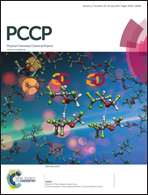Visible light absorption and photoelectrochemical activity of colorless molecular 1,3-bis(dicyanomethylidene)indane (BDMI) by surface complexation on TiO2†
Abstract
Adsorption of the colorless 1,3-bis(dicyanomethylidene)indane (BDMI) onto a nanocrystalline TiO2 surface unusually turned the BDMI a deep blue color. Upon contact of the BDMI-adsorbed TiO2 (BDMI-TiO2) with an iodide-based redox electrolyte, a photocurrent density as high as 14.9 mA cm−2 was generated with a photovoltage of 0.42 V, leading to a power conversion efficiency of 3.63%. This unprecedented photovoltaic performance was simultaneously investigated by spectroscopic studies of BDMI-TiO2 films and density functional theory (DFT)/time-dependent DFT (TD-DFT) computational approaches for [BDMI]−[Ti(OH)3·H2O]+ (1) as a simple model compound to inspect the light to current conversion abilities. All these results established that the color change from colorless to deep blue and the highly efficient photocurrent generation through binding on the TiO2 surface originates from interfacial charge transfer transitions from anionic BDMI to TiO2.


 Please wait while we load your content...
Please wait while we load your content...